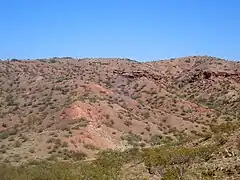Sierra Ladrones Formation
The Sierra Ladrones Formation is a geologic formation exposed near the Rio Grande Valley in New Mexico. It preserves fossils of Pliocene to Pleistocene age.[1]
| Sierra Ladrones Formation | |
|---|---|
| Stratigraphic range: Pleistocene to Pliocene | |
 Sierra Ladrones Formation northeast of Socorro, New Mexico, USA | |
| Type | Formation |
| Unit of | Santa Fe Group |
| Overlies | Popotosa Formation |
| Thickness | 470 m (1,540 ft) |
| Lithology | |
| Primary | Sandstone |
| Other | Siltstone, conglomerate |
| Location | |
| Coordinates | 34.3939496°N 107.0007996°W |
| Region | New Mexico |
| Country | United States |
| Type section | |
| Named for | Sierra Ladrones (mountain range) |
| Named by | M.N. Machette |
| Year defined | 1978 |
 Sierra Ladrones Formation (the United States)  Sierra Ladrones Formation (New Mexico) | |
Description
The formation consists of three facies representing different depositional environments. These are piedmont slope and alluvial fan deposits, typically composed of light-brown to light-reddish-brown sandstone and fanglomerate; axial stream deposits, which are composed of light-gray to light-yellowish-brown fine- to medium-grained sand and sandstone with fluvial cross-bedding and cut-and-fill channels; and interbedded basalt flows with a K-Ar age of 4.5 +/-0.1 million years (Ma. The total thickness is in excess of 470 m (1,540 ft).[1] The formation unconformably overlies or is in fault contact with the Popotosa Formation or older formations. Its age is early Pliocene to middle Pleistocene (2 Ma to 5 Ma.)[1]
The formation is interpreted as fanglomerates shed from the flanking uplifts of the Rio Grande Rift and channel and floodplain deposits of the ancestral Rio Grande.[2]
Fossils
The formation has yielded abundant fossils of Irvingtonian age at Tijeras Arroyo, south of Albuquerque International Airport. These include Hypolagus, Equus, Mammuthus, and Hesperotestudo.[3]
History of investigation
The formation was defined by M.N. Machette in 1978 for exposures in the Sierra Ladrones, a range of low foothills of the Ladron Mountains, in the Sevilleta National Wildlife Refuge.[1]
The formation was subsequently mapped into the lower Rio Puerco valley[4] and as far north as the Santo Domingo basin.[5]
Footnotes
- Machette 1978.
- Osburn & Chapin 1983.
- Lucas 1997, p. 228.
- Love & Young 1983, p. 280.
- Smith & Kuhle 1998.
References
- Love, David W.; Young, John D. (1983). "Progress report on the late Cenozoic geologic evolution of the lower Rio Puerco" (PDF). New Mexico Geological Society Field Conference Series. 34: 277–294. Retrieved 18 May 2020.
- Lucas, Spencer G. (1997). "New Mexico's Fossil Record 2". New Mexico Museum of Natural History and Science Bulletin. 16. Retrieved 18 May 2020.
- Machette, M.N. (1978). "Geologic map of the San Acacia quadrangle, Socorro County, New Mexico". U.S. Geological Survey Geologic Quadrangle Map Series. GQ-1415. Retrieved 18 May 2020.
- Osburn, G.R.; Chapin, C.E. (1983). "Nomenclature for Cenozoic rocks of northeast Mogollon-Datil volcanic field, New Mexico". New Mexico Bureau of Mines and Mineral Resources Stratigraphic Chart Series. 1. Retrieved 18 May 2020.
- Smith, G.A.; Kuhle, A.J. (1998). "Geology of the Santo Domingo Pueblo and Santo Domingo Pueblo SW 7.5-minute quadrangles, Sandoval County, New Mexico". New Mexico Bureau of Mines and Mineral Resources Open-File Map Series. OF-GM 15/26. Retrieved 18 May 2020.